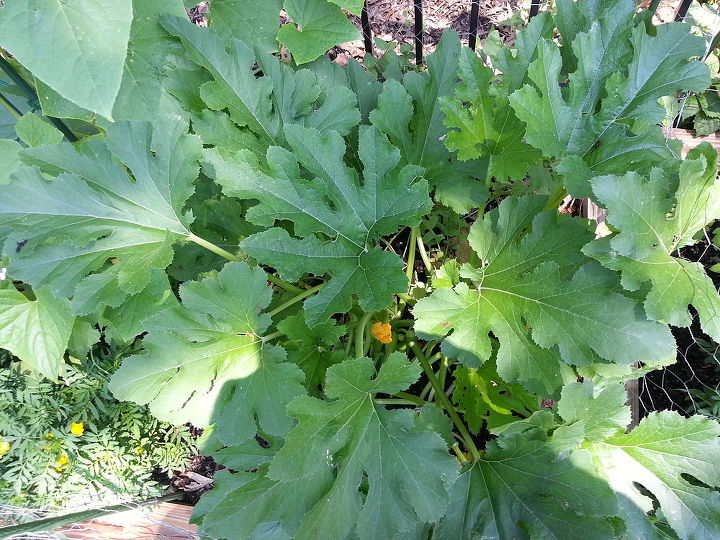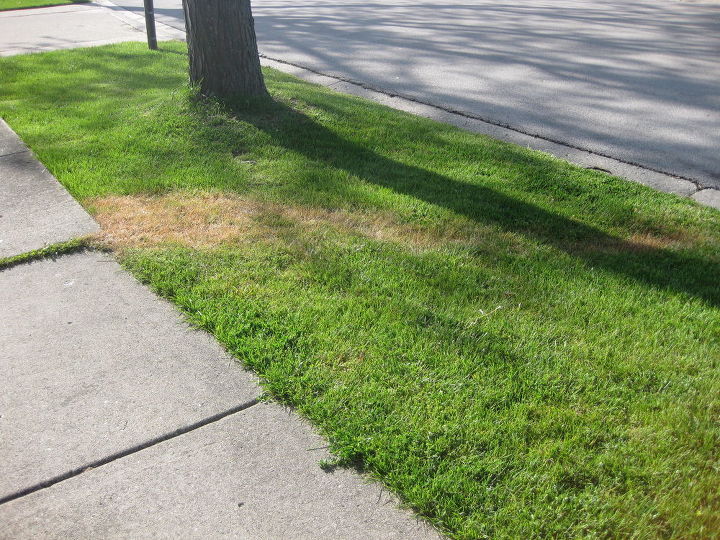Im so frustrated with the soil in my front and back yard.

-
I live in Colorado (right next to the Utah border) and we have the same crappy cement hard, heavy clay type soil. I keep adding compost, garden soil and organic materials (leaves, grass clippings, etc.) to try to get my garden to grow, but it's a struggle. :( Keep at it and try your local trash pick-up/Dump and see if they offer free organic compost. It's the best stuff to add to the soil because it has the nutrients the plants need to grow and it helps the heavy clay both drain too much water and retain water for the plants to use later (when my soil gets wet it becomes water proof, so no moisture penetrates the top 2" then it dries into super hard 'cement'- horrible stuff). Good luck!
 Jennifer G
on Jul 25, 2014
Helpful Reply
Jennifer G
on Jul 25, 2014
Helpful Reply -
-
I live in Southern Oregon, on land that is a dry river bed. Rocks galore, more like gravel. We joke about it around here, that we can't grow anything but rocks. This year we started our vegetable garden in raised beds consisting of pine bedding (the kind you use for rabbits) and straw. So far our garden is the best it has ever been. A plus, no digging. We just layered wood chips & straw, and put composted soil where we wanted to plant. We even planted blueberries in it.
 Karen Lindsay
on Jul 25, 2014
Helpful Reply
Karen Lindsay
on Jul 25, 2014
Helpful Reply -
-
Hi Nikki- sounds like a "tough" situation. You may want to try using "lasagna gardening"- Check out what I did with my backyard. It worked for me- I covered my entire backyard with layers of: brown paper yard waste bags, then garden soil, then mulch. After that I was able to plant and the flowers have come out really nice this year! Check out my post: http://www.squidoo.com/creating-garden-magic Good luck!
 Ivylore
on Jul 25, 2014
Helpful Reply
Ivylore
on Jul 25, 2014
Helpful Reply -
-
You could also try coffee grounds. Believe it or not clay hard earth coffee grounds and fish with some fresh manure might help your plants grow. Using things like a good quality root starter and miracle grow (sparingly) will also help especially if you just planted.
 Lisa
on Jul 25, 2014
Helpful Reply
Lisa
on Jul 25, 2014
Helpful Reply -
-
when you plant,make sure you use a bunch of potting soil for each plant.unless you can afford to do the whole yard,haha.
 Joedean Small
on Jul 26, 2014
Helpful Reply
Joedean Small
on Jul 26, 2014
Helpful Reply -
-
No matter where you garden, you have to nurture the soil. Your first step in doing that is to get a soil test. You can get one from Utah State for $10. It will be the best money you spend in your garden. It will tell you what you need to add in terms of amendments, and tell you the pH of your soil. In Utah, soil tends to be on the alkaline side, so if you are planting plants that like things acidic, they are never going to be happy. If you plant Utah natives, they are going to have evolved to handle the soil that has you in such despair. I'd highly recommend checking out this info from Utah State: http://extension.usu.edu/files/publications/factsheet/hg_h_01.pdf
 Douglas Hunt
on Jul 26, 2014
Helpful Reply
Douglas Hunt
on Jul 26, 2014
Helpful Reply -
-
I live in Michigan but our soil here is very lean and sandy - NOTHING grows here unless I amend it. And I believe in being totally organic (since we drink our well water and grow food to eat here) so no Miracle Grow for us. So I "amend" our soil for a couple of years before I plant and that has really helped with my gardening. I create the bed area and add whatever organic material I can to that bed and allow it to break down and dig it in. I've used mushroom compost, well composted horse manure, my own homemade compost (from clippings and kitchen scraps broken down into soil and bark chips.) Some use newspapers and cardboard too. Also you can also order gardening soil by the yard or truckload if you desire. This all does take time and patience but really pays off in the end. Without good soil you are mostly wasting money on shrubs, trees and perennials and your time too. (LOTS of book out there too.) I'm working on building a bed right now that will hold a staggered privacy panel, an evergreen and climbing/flowering perennials (three panels/four evergreens/staggered). I piled on 3-4" of composted horse manure and added 2-3" of bark chips on top. This will sit for a year or more until we get our current project completed (a chicken pen and coop) and then we will turn this soil over, put in the panels and plant evergreens and flowering climbers. After it's all planted I will cover up with more bark chips to keep the weeds at bay and the chips will eventually break down, improving the soil. This system has been developed over the past 15 years and works well for us. Check out the Back to Eden Gardening site for lots of tips on using bark chips. Donna at The Small House Under a Big Sky
 White Oak Studio Designs
on Jul 26, 2014
Helpful Reply
White Oak Studio Designs
on Jul 26, 2014
Helpful Reply -
-
I think the best advice you can get is to call your County Extension Office. The County Educator and give you the best advice.
 Marcia Espeland
on Jul 26, 2014
Helpful Reply
Marcia Espeland
on Jul 26, 2014
Helpful Reply -
-
Whatever it is in your yard that you do not like or presents a big (and expensive) project, don't fight it, play into it. Hard crappy, cement like ground? Think rocks, large planters, interesting pieces and few grassy areas by digging out and adding a lot of top soil! Put in large islands for fun and then just a small amount of grass. (See photos) A few large pots scattered about can add some flowers if you want flowers. There is a post by Kelly Jo that came in today that has "Industrial Flowers" that are ADORABLE! I am definitely going to make myself some! They are actually works of art!
 Jeanette S
on Jul 26, 2014
Helpful Reply
Jeanette S
on Jul 26, 2014
Helpful Reply -
-
Similar problem here in Nv....either caliche clay (when wet it glues to your shoes until each foot weighs 10 pounds or so and slippery.....dries to concrete that you can drive a truck over for a year without breaking it down) or sand....neither one grows anything except, occasionally, sagebrush or goats heads. UGH!! I gave up trying to make a yard with grass (some succeed by laying sod but then have to water the heck out of it and with water reserves being what they are..that didn't seem to be reasonable). So.....I made raised beds, bordering with landscape timbers (at a salvage store they were $2 each), rocks, cinder blocks...whatever I could find. I then contacted hay ranchers for any damaged bales of hay and spread that out maybe 6-8 inches deep (a "flake" or two depending on how thick they were). I added some aged manure (talk to cattle ranchers, chicken farmers, horse owners), grass cuttings (from those folks that laid sod and then had to mow the stuff) and then in the fall, posted notices and put an ad in the local paper that I would pick up bags of leaves (there are some trees in town) and dumped bag after bag. I wet the whole thing down in the fall and covered it with black plastic for the winter....anchoring that with some rocks here and there. By spring it was really well composted and then I added (at some cost but worth it) some bags of garden soil (not potting soil) from WalMart and worked that in. Then planted each bed thickly with whatever I had in mind....some went to veggies and some to flowers. If the bed had rather ugly borders (think the cinder blocks) I planted stuff that would drape over the edges and cover them. Then I used either gravel or talked with the tree trimming service about dumping their chipped up tree trimmings to put in the walkways between beds. Each bed could be watered with the amount needed (I planted water thirsty stuff closest to the house and more xeric stuff further out since I hate dragging hoses around). Took about 2 years to get set up. I'm also lazy enough that I used perennials as much as possible, tucked food plants in among the flowers here and there (asparagus makes a lovely lacey background for annual flowers for instance...and rhubarb is a big leaved performer) and saved seed from the annuals to plant the next season or looked for volunteers and transplanted to where I could use them.
 Dorothy
on Jul 27, 2014
Helpful Reply
Dorothy
on Jul 27, 2014
Helpful Reply -
Related Discussions
GNATS - How to get rid of them?
Somehow my house and garden got tiny gnats that killed my fuchsia plant and fly everywhere. I have tried ALL the Web recommendations - soap and oil dishes, sand in th... See more
Marigolds growing! Should I pinch the buds?
My marigold plants are growing. I heard that pinching the buds until Autumn will allow them to grow without killing the plant. Is this true?
Growing garlic
Growing our first garlic, should we wait until the leaves are drying out before we pick it? Husband picked first one today along with our first potatoes.
How to keep mice out of your garden?
Hi everyone, I have mice in my garden destroying my vegetables and I have also noticed them in the barn and shed. Please can someone tell me how to prevent them from ... See more
What's the best flower/plant to grow in Texas?
I know that opinions vary, but what's your opinion?!I have great luck w Rosemary plants. Green all year long.
Squash Plants Large and Healthy and no Squash Growing?
2nd Season in a ROW! Squash plants growing large and healthy leaves and the stems near the roots are looking healthy and turning dark green, getting flowers that grow... See more
Trail of dead grass mystery?
Trail of dead grass appeared two weeks ago that starts in neighbor's yard and goes to the sidewalk, then continues past the sidewalk in a line into the grass into my ... See more







